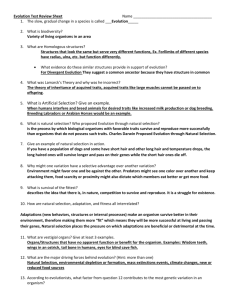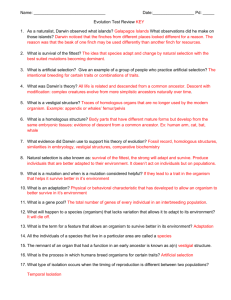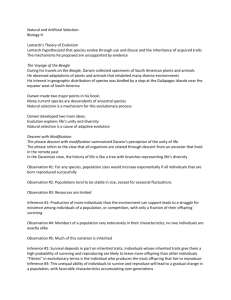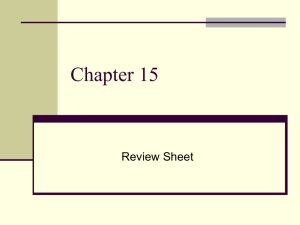Evolution
advertisement
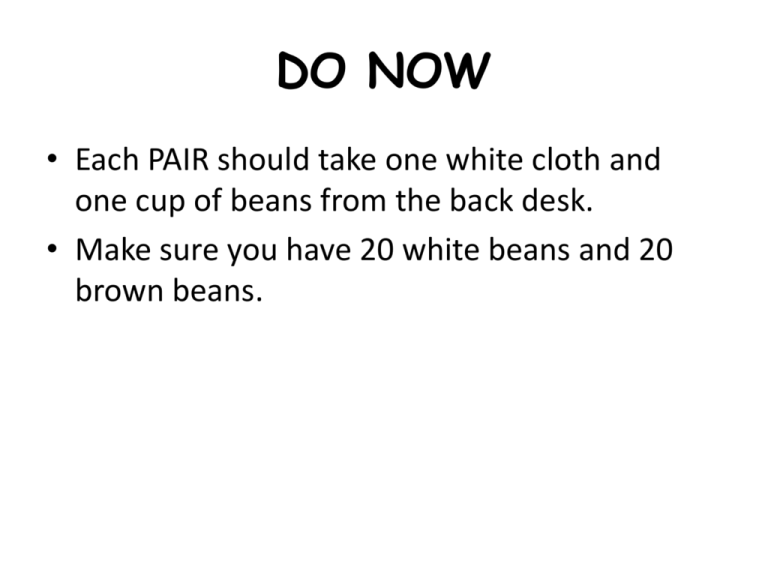
DO NOW • Each PAIR should take one white cloth and one cup of beans from the back desk. • Make sure you have 20 white beans and 20 brown beans. Class Results Number of Brown Beans Picked Number of White Beans Picked Total Total Changes Over Time Chapter 6 Mutations Section 1: Darwin’s Theory Evolution: • The process in which inherited characteristics within a population change over generations such that new species sometimes arise. To Understand Darwin: • Species: A group of organisms that are closely related and that can mate to produce fertile offspring. • Variation: A difference in characteristics, or traits among members of the same species. • Adaptation: A characteristic that improves an individual’s ability to survive and reproduce in a particular environment Charles Darwin • In 1831, a 22 year old named Charles Darwin served as a “naturalist” on the HMS beagle during it’s 5-year trip around the world. Charles Darwin Charles Darwin • Darwin’s important discoveries included the diversity of living things, the remains of ancient organisms, and the characteristics of organisms of the Galapagos Islands. • Darwin's Voyage Finches Tortoises Charles Darwin Natural Selection: • The process by which individuals that are better adapted to their environment survive and reproduce more successfully than less well adapted individuals. • Natural Selection is a theory to explain how evolution happens. Natural Selection 1. Overproduction – more young are born than can survive. Natural Selection 2. Inherited Variation – there are differences within the genes of every population or species ( the result of random mutation and translation errors) Natural Selection 3. Struggle to Survive – Because of the overproduction, there is a competition for limited resources. Some individuals are better suited to survive as a result of variation. Natural Selection 4. Selection– Darwin proposed that over a long time, natural selection can lead to change. Helpful variations will gradually accumulate in a species, while unfavorable ones may disappear. Natural Selection Successful Reproduction – Those individuals with adaptations that made them more “fit”, survive and pass those traits on to their offspring. Therefore those traits become more common in the population. Natural Selection 4. Successful Reproduction – Those individuals with adaptations that made them more “fit”, survive and pass those traits on to their offspring. Therefore those traits become more common in the population. DO NOW • Take out your finches homework. MAKE SURE YOUR NAME IS ON IT. Put it in the class folder. • Take a number from the back desk. • Find the station with the matching number and work together with other students in that group to answer the question. (answers will be shared with the class) 1. Who was Charles Darwin, and what did he do on the Beagle’s voyage? 2. What is evolution? 3. Explain how the shape of a finch’s beak is an example of an adaptation. 4. When members of a species compete, what do they compete for? 5. What happens when species overproduce offspring? 6. Suppose a variation makes an individual member of a species better adapted to its environment. How might that variation affect the individual’s reproduction? 7. How does the environment “select” organisms? 8. How do helpful variations accumulate in a species over time? 9. Why can only traits controlled by genes be acted upon by natural selection? Myth 1 Myth 2 Katherine Katie Hailey Annesha Ryan Drum Peter Vincent Matt P Aiden Rachel Myth 3 Myth 4 Ryan K Nate Elizabeth Emily Sam Matt N Margo Liam Naila Veronica James Mike Myth #1 If a four legged animal walked on its hind legs enough, then it’s offspring would be more likely to be born able to also walk on it’s hind legs. Myth #2 Since evolution is just a theory, it is no more likely to be true than any other guess. Myth #3 Since nobody actually saw it happen, you can’t be sure that evolution actually goes on. (There is no real evidence to back it up.) Myth #4 Human evolved from monkeys. Before you go… • Write a one-two sentence statement that appropriately uses all three of the following terms (in any order): Variation Adaptation Environmental Pressure • Write your answer on the index card and hand it to Mrs. Burke on your way out. Class Data Beak Spoon Binder Clip Tweezers Scissors Paper Clips Rubber Bands Toothpicks Macaroni Index cards DO NOT TOUCH ANYTHING IN THE LAB STATIONS OR MOVE THE STOOLS Do Now What variations exist among the to cacti in the picture? Which is an adaptation and why? Section 2: Evidence of Evolution Interpreting the evidence • Fossils, patterns of early development, and similar body structures all provide evidence that organisms have changed over time. Evidence of Evolution The Fossil Record • Fossils provide an actual record of Earth’s past life forms. • By dating the rocks in which fossils are found, we can arrange the fossils in order from oldest to youngest and see patterns of inheritance. Evidence of Evolution The Fossil Record Evidence of Evolution Homologous Structures • Similarities in different organisms body structures provides evidence that those organisms evolved from a common ancestor. • Similar structures that related species have inherited from a common ancestor are known as homologous structures. • (same structure, but different function) Evidence of Evolution Homologous Structures Homologous structures show how similar structures have evolved to have different functions in different species. Evidence of Evolution Vestigial Structures • Sometimes bones are present in a organism, but are reduced in size and either have no use, or a less important function than they do in other related organisms. • These structures are known as vestigial structures. Evidence of Evolution Vestigial Structures Evidence of Evolution Vestigial Structures Evidence of Evolution Similarities on DNA • Comparing the DNA of different species can show how closely related they are. • The more similar the DNA sequence, the more closely related the species are. The sequences of human and chimpanzee DNA are 81-98 % identical! Combining Evidence • Scientists combine all of these different types of evidence of species relationships and use it to create branching trees. Branching Trees • Branching trees are diagrams that show how scientists think species are related. Common Ancestry Common Ancestry The Tempo of Evolution • Gradualism: gradual change over a long period of time leads to species formation. • Punctuated Equilibrium: Periods of rapid change in species are separated by periods of little or no change. (Successful species may stay unchanged for long period of time. Major environmental changes may cause evolution to occur in spurts.) How Do New Species Form? • Speciation: the process by which new species form. How Do New Species Form? • A new species can form when a group of individuals remains isolated from the rest of the species long enough to evolve different traits. How Do New Species Form? Do Now What types of evidence do scientists use to determine evolutionary relationships among groups? Compare the flipper of a seal to the wing of a bird… Think about the answers to these questions and discuss your ideas with your partner. In three minuets you will share with the class… • What do scientists infer from the similarities between these two structures? • What do scientists call such similar structures? • Describe how DNA evidence might be used to confirm scientists’ conclusions about any relationship between birds and seals. • What do similarities in the early development of organisms suggest? Looking at the Evidence Homologous vs. Analogous Homologous: similar structures although they have different functions in the different organisms. Analogous: The structures are different, although they serve the same function for the organisms. Looking at the Evidence Homologous vs. Analogous • Homologous Structures were inherited from a common ancestor, so they still resemble each other even though they are being used for different functions. (same structuredifferent function) • Analogous Structures resemble each other externally because they are being used for similar functions in a similar environment, but they are not actually that similar in structure internally because they were not inherited from a common ancestor. (same function – different structure) Looking at the Evidence Vestigial Structures Looking at the Evidence DNA Sequence and Embryo Development Adaptation of the Human Hand • One of humans’ adaptations that has given us a great advantage over other animals is our opposable thumb, which allows us to grasp objects. • Today’s lab will demonstrate how the human hand is adapted to the actions it performs. The Mystery Fossil Bones Activity DIRECTIONS: 1. On your desk you will find a set of mystery bones. Every group member should help cut out the mystery fossil bones. 2. Then your group will brainstorm ideas on how you think the bones go together. You may try multiple rearrangements until the group agrees on a final bone structure for the mystery organism. 3. Once you have agreed, glue the bones on to the large piece of paper that was provided for you at your station. 4. Next your group must decide what the outside of the animal looked like. Was it covered with skin, fur, scales, something else? How large was it? What did it eat? 5. Add these details to your groups poster. VOCABULARY Evolution • The process in which inherited characteristics within a population change over generations such that new species sometimes arise. Adaptation • A characteristic that improves an individual’s ability to survive and reproduce in a particular environment Variation • A difference in characteristics, or traits among members of the same species. Species • A group of organisms that are closely related and that can mate to produce fertile offspring. Homologous Structures • Similar structures that related species have inherited from a common ancestor. (same structure, but different function) Analogous Structures • Structures that resemble each other externally because they are being used for similar functions in a similar environment, but they are not actually that similar in structure internally because they were not inherited from a common ancestor. (same function – different structure) Vestigial Structures • Structures that are present in a organism, but are reduced in size and either have no use, or a less important function than they do in other related organisms. Gradualism • Gradual change over a long period of time leads to species formation. Punctuated Equilibrium • Periods of rapid change in species are separated by periods of little or no change. Natural Selection 1. Overproduction – more young are born than can survive. Natural Selection 2. Inherited Variation – there are differences within the genes of every population or species ( the result of random mutation and translation errors) Natural Selection 3. Struggle to Survive – Because of the overproduction, there is a competition for limited resources. Some individuals are better suited to survive as a result of variation. Natural Selection 4. Selection– Darwin proposed that over a long time, natural selection can lead to change. Helpful variations will gradually accumulate in a species, while unfavorable ones may disappear. Homologous same structure – different function Analogous same function – different structure Vestigial VARIATIONS • • • • • • Shell size and shape among the tortoises Length of individual tortoises’ legs Different Shell Colors and Patterns Amount of blubber each penguin has Penguin Height Length of Penguin Beaks Adaptations • Longer legs on a tortoise. • High arching shells that sit far back on the shoulders. • A gene mutation that increases the amount of blubber a penguin has. • Markings that make an individual attractive to the opposite sex. Environmental Pressures • • • • • • Drought Location of the food supply Predators Competition for mates Extreme Temperatures Limited Habitat Space Essay: • Darwin said “It is not the strongest of the species that survive, nor the most intelligent, but the one most responsive to change.” How do genetics and evolution work together to allow certain species to change while others become extinct? Your Essay Should Include: • All offspring inherit their DNA from their parents. • Genes are carried from parents to offspring on chromosomes. • Because of this no two members of the same species are genetically identical. (variation) • Within any population, there will be overproduction causing a struggle to survive when members of the same species have to compete for limited resources. • Because of the variations that the offspring inherited from their parents, some will be better at getting those limited resources than others (adaptation) • These better adapted individuals will be more likely to survive and reproduce, passing on the adaptations to their own offspring. • Over time the better adapted traits will build up in the population and the species will slowly change. (evolution)

